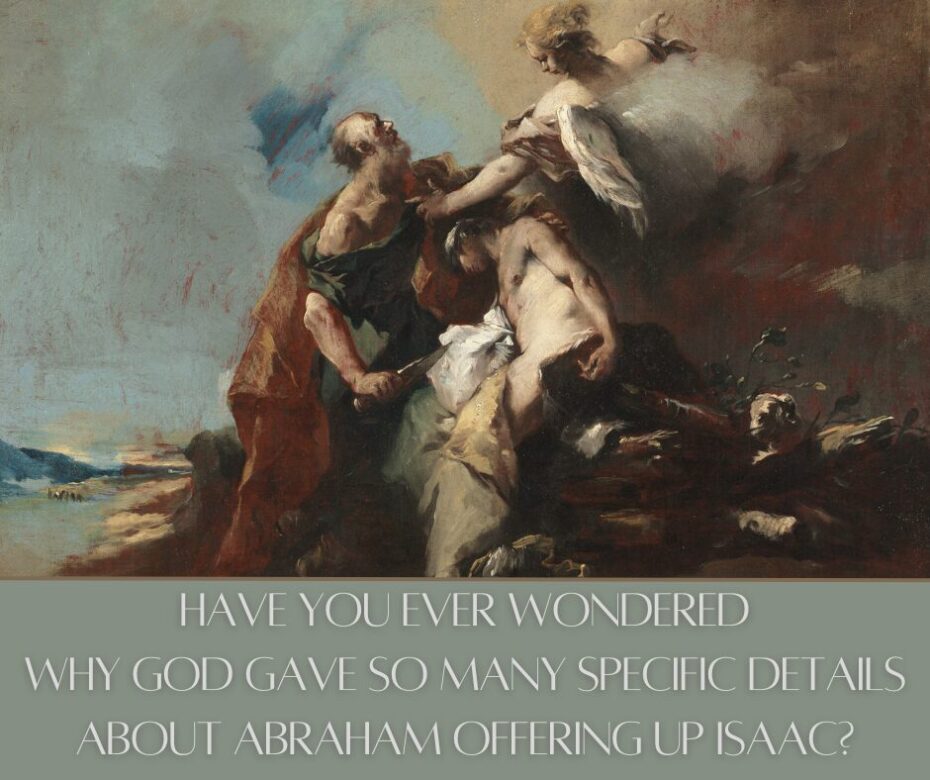Yesterday, I had the privilege of listening to a compelling sermon by Philippe Sterling on the parallels between Isaac and the Lord Jesus. I’ve invited him to contribute an article to the magazine on this topic. This blog serves as an initial exploration of this fascinating subject.
A Biblical type is a historical incident that is recorded in the Bible and that has profound prophetic significance.
Biblestudytools.com defines a Biblical type in this way (see here):
The word “type” is derived from a Greek term tupos, which occurs 16 times in the New Testament. It is variously translated in the King James Version, e.g. twice “print” (John 20:25); twice “figure” (Acts 7:43; Romans 5:14); twice “pattern” (Titus 2:7; Hebrews 8:5); once “fashion” (Acts 7:44); once “manner” (Acts 23:25); once “form” (Romans 6:17); and seven times “example” (1 Corinthians 10:6, 11; Philippians 3:17; 1 Thessalonians 1:7; 2 Thessalonians 3:9; 1 Timothy 4:12; 1 Peter 5:3). It is clear from these texts that the New Testament writers use the word “type” with some degree of latitude; yet one general idea is common to all, namely, “likeness.” A person, event, or thing is so fashioned or appointed as to resemble another; the one is made to answer to the other in some essential feature; in some particulars, the one matches the other. The two are called type and antitype, and the link that binds them together is the correspondence, the similarity, of the one with the other.
Of those sixteen uses, only one, Rom 5:14, identifies an OT person, Adam, as a type of Christ.
Twice, the NT identifies a type by using the corresponding word antitype (antitupos).
Peter said that the ark that saved Noah and his family from physical death is an antitype of baptism, which saves the believer from temporal judgment (1 Pet 3:21). (Some understand this verse to refer to Holy Spirit baptism [1 Cor 12:13], when believers are placed into the Body of Christ.)
The author of Hebrews said that the Temple and its ministry was an antitype of heaven and its ministry (Heb 9:24).
Some places in the NT identify types without using the words tupos or antitupos. The word as can specify a type. The Lord Jesus said, “As Moses lifted up the serpent…so must the Son of Man be lifted up” (John 3:14). Paul said, “As Isaac was, [we] are children of promise” (Gal 4:28).
Sometimes, a repeated rare word can signal a type. The word monogenēs, meaning one and only or only begotten, occurs nine times in the NT. Five of those times, it refers to Jesus Christ (John 1:14, 18; 3:16, 18; 1 John 4:9). Once, it refers to Isaac as Abraham’s only begotten son (Heb 11:17). (The other three uses refer to people who have but one son or daughter: Luke 7:12; 8:42; 9:38.)
We know that when Abraham offered up Isaac, that was a type of God the Father offering up His Son. But we may not know all the amazing parallels.
Isaac was the son of promise (Gal 4:23). So was the Lord Jesus Christ (Gen 15:1-5; Isa 7:14).
Abraham offered up his only begotten son: “By faith Abraham, when he was tested, offered up Isaac, and he who had received the promises offered up his only begotten son” (Heb 11:17). (He had other sons, but they were not the son of promise, who had to come from him and Sarah. Biblically speaking, Isaac was his only son.) God the Father offered up His only begotten Son as well (John 3:16).
Isaac carried the wood of the sacrifice (Gen 22:6), which shows that he was probably ten to twelve years old. The Lord Jesus bore the wood of His sacrifice (John 19:17).
Isaac’s birth was miraculous: Sarah had gone through menopause decades earlier. The Lord Jesus’ birth was miraculous: Mary was a virgin.
God, not their parents, named both Isaac and Jesus.
Isaac accepted his father’s will and allowed himself to be tied up and placed on the altar as a sacrifice (Gen 22:9-10). The Lord Jesus accepted his Father’s will and allowed Himself to be arrested, beaten, mocked, scourged, and killed on the cross.
The location of the two sacrifices was the same. Isaac was offered up on Mount Moriah. Golgotha, the place of Jesus’ crucifixion, was on Mount Moriah.
There was one big difference. The Lord Jesus stopped Abraham from sacrificing Isaac. God the Father did not stop the Romans from crucifying His Son.
For more details (and additional possible parallels), see this article by Stephanie Solberg.


